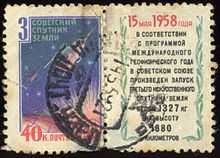Sputnik 3
 | |
| Mission type | Earth Science |
|---|---|
| Harvard designation | 1958 Delta 2 |
| SATCAT № | 8 |
| Website | NASA NSSDC Master Catalog |
| Mission duration | 692 days |
| Spacecraft properties | |
| Manufacturer | Korolev Design Bureau |
| Launch mass | 1,327 kilograms (2,926 lb) |
| Start of mission | |
| Launch date | May 15, 1958, 07:12:00 UTC |
| Rocket | Sputnik 8A91 |
| Launch site | Baikonur 1/5 |
| End of mission | |
| Decay date | April 6, 1960 |
| Orbital parameters | |
| Reference system | Geocentric |
| Regime | Low Earth |
| Semi-major axis | 7,418.7 kilometres (4,609.8 mi) |
| Eccentricity | 0.110932 |
| Perigee | 217 kilometres (135 mi) |
| Apogee | 1,864 kilometres (1,158 mi) |
| Inclination | 65.18 |
| Period | 105.9 minutes |
| Instruments | |
|---|---|
| Upper Atmosphere : | Composition of the upper atmosphere |
| Geiger counters : | Charged particles |
| Micrometeoroid detectors : | Micrometeoroids |
Sputnik 3 (Russian: Спутник-3, Satellite 3) was a Soviet satellite launched on May 15, 1958 from Baikonur cosmodrome by a modified R-7/SS-6 ICBM. It was a research satellite to explore the upper atmosphere and the near space and carried a large array of instruments for geophysical research.

Sputnik 3 was the only Soviet satellite launched in 1958. Like its American counterpart, Vanguard 1, Sputnik 3 had succeeded in making it into orbit during the IGY.[1]
History
In July 1956, the Soviet Union's OKB-1 drafted a project to design and build the first Earth satellite, designated ISZ (Artificial Earth Satellite). ISZ was known to its designers as "Object D."[2] Design of Object D had begun in January 1956 with intent to launch it during the International Geophysical Year.[3] Object D was planned to be the first satellite launched by the Soviet Union but ended up being the third following delays due to problems developing the extensive scientific experiments and their telemetry system.[4] The new R-7 intercontinental ballistic missile, also known by its GURVO designation 8K71,[5] was ready to launch before Object D was finished. Worried at the prospect of America launching a satellite before he did, Sergei Korolev substituted the relatively simple "Prosteyshiy Sputnik-1" meaning "Simple Satellite 1", or PS-1, which was labeled Sputnik 1 by the Soviet Government, as the first satellite to be launched instead. The Sputnik 2 (PS-2) was also ready and launched earlier than Object D.
Launch
Sputnik 3 was launched by a modified R-7 Semyorka missile developed for satellite launches, the Sputnik 8K91.[6] Following a launch failure on 27 April 1958,[7] a development of Object D[2] finally reached orbit, having been launched at 07:00:35 on 15 May 1958; the Soviet Government designated it Sputnik-3. Sputnik 3 was an automatic scientific laboratory spacecraft. It was conically shaped and was 3.57 m (11.7 ft) long and 1.73 m (5.68 ft) wide at its base. It weighed 1,327 kg (1.46 tons). The scientific instrumentation (twelve instruments) provided data on pressure and composition of the upper atmosphere, concentration of charged particles, photons in cosmic rays, heavy nuclei in cosmic rays, magnetic and electrostatic fields, and meteoric particles. While The Earth's outer radiation belts were detected during the flight, its Tral-D tape recorder failed, so it was unable to map the Van Allen radiation belt.[8] The Soviets, without full evidence, were "hog-tied".[9] The spacecraft remained in orbit until 6 April 1960, when the orbit degraded from drag in the upper atmosphere to the point where the satellite reentered the atmosphere, disintegrating before impact.[10]
See also
- modified R-7/SS-6 ICBM
- List of unmanned spacecraft by program
Footnotes
- ↑ Green, Constance McLaughlin, and Lomax, Milton.. Vanguard a History, Washington D.C., National Aeronautics and Space Administration, 1970, p. 219. NASA SP-4202
- ↑ 2.0 2.1 Siddiqi, Asif A.. Sputnik and the Soviet Space Challenge, Gainesville, Florida. The University of Florida Press, 2003, p. 176. ISBN 0-8130-2627-X
- ↑ Siddiqi, Asif A.. Sputnik and the Soviet Space Challenge, Gainesville, Florida. The University of Florida Press, 2003, p. 149. ISBN 0-8130-2627-X
- ↑ Harford, James.. Korolev how one man masterminded the Soviet drive to beat America to the Moon, New York. John Wiley & Sons, Inc., 1997, p. 126. ISBN 0-471-14853-9
- ↑ Zaloga, Stephen J.. The Kremlin's Nuclear Sword, Washington. The Smithsonian Institution Press, 2002, p. 232. ISBN 1-58834-007-4
- ↑ Siddiqi, Asif A.. Sputnik and the Soviet Space Challenge, Gainesville, Florida. The University of Florida Press, 2003, p. 175. ISBN 0-8130-2627-X
- ↑ "Sputnik 3". Retrieved 2010-05-26.
- ↑ Siddiqi, Asif A.. Sputnik and the Soviet Space Challenge, Gainesville, Florida. The University of Florida Press, 2003, p. 175-176. ISBN 0-8130-2627-X
- ↑ Harford, James.. Korolev how one man masterminded the Soviet drive to beat America to the Moon, New York. John Wiley & Sons, Inc., 1997, p. 136. ISBN 0-471-14853-9
- ↑ "Sputnik 3 - Scientific Laboratory". Robert Christy. Retrieved 2011-06-30.
References
- Harford, James.. Korolev, New York. John Wiley & Sons, Inc., ISBN 0-471-14853-9.
- Siddiqi, Asif A., Sputnik and the Soviet Space Challenge, Gainesville, FL. The University of Florida Press, ISBN 0-8130-2627-X.
- Zaloga, Stephen J.. The Kremlin's Nuclear Sword, Washington. The Smithsonian Institution Press, ISBN 1-58834-007-4.
External links
- A film clip "Russian exhibit of Sputnik, 1958/06/09" is available for free download at the Internet Archive [more]
- Sputnik: 50 Years Ago
- NSSDC Master Catalog: Spacecraft Sputnik 3
- Sputnik 3 - Encyclopedia Astronautica
- Sputnik 3 Diary
| ||||||||